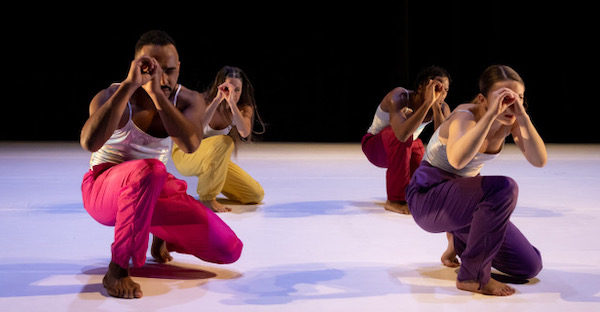Dance Review: Boston Dance Theater’s “Carol Kaye Project” — A Thrilling Tribute
By Jessica Lockhart
Bravo for the Boston Dance Theater’s decision to venture outside of Boston and perform at an interesting venue in Portland, ME.
The Carol Kaye Project, performed by Boston Dance Theater at the Space Gallery, Portland, ME (June 9 and 10)

A scene from Boston Dance Theater’s The Carol Kaye Project. Photo: Melissa Blackall
Space Gallery in downtown Portland, Maine is known for presenting musicians and performers who are among the hippest, strangest, most far-out, coolest, and edgiest in their field. It has the additional merit of being a small venue: each performance feels very intimate. So, when Boston Dance Theater stepped into the space, audience members were only inches away from the proceedings, surrounding the performers on three sides. We could see every move — up close!
Space Gallery’s limited size makes seeing exercises in large-scale choreography somewhat challenging, but it was the perfect choice of a stage for this particular show, a tribute to musician and electric bass player Carol Kaye. Space Gallery often welcomes creative deep dives into lesser known but oh-so important artists. The Carol Kaye Project draws on the efforts of four choreographers to pay homage to Kaye’s invaluable contributions as a recording session musician: she was a part of a number of iconic ’60s and ’70s pop music recordings. Each segment turned tunes into movement, and each interpretation was distinct. A lot of props are used throughout the evening: real guitars, sunglasses, mics on mic stands, chairs. Add in costume changes and you have a show with a cabaret-like feel.
First up was “Carol/Karole,” choreographed by Karole Armitage. This dance suffered from being confined to a relatively small dance floor; a lot of the choreography was designed to look glorious on a big stage, with its 5 dancers asked to make big leaps and jumps. Here they were forced to hold back a bit, and they still ran out of space. The performers took smaller steps and that cramped the piece’s style. Armitage’s movements mimicked the songs: For “These Boots Are Made for Walkin'” the dancers marched around in the eponymous stompers. For the theme of “Mission Impossible,” the dancers moved sneakily around the stage as they were spies in action. Fun, but a little too cute.

A scene from Boston Dance Theater’s The Carol Kaye Project. Photo: Melissa Blackall
“For the Record” was choreographed by Rena Butler in 2020. Conceived during the pandemic, it was the first commissioned piece in The Carol Kaye Project. This dance fit wonderfully into an intimate space. The 6 dancers only moved to the sound of a bass line: their bodies twisted into the shapes of guitars with each thump. thump. thump. The performers moved with rhythmic quirkiness, and it was mesmerizing. Beginning with the popular songs of Frank and Nancy Sinatra, the sound eventually changed to a room-filling low static humming. That became a drone and we were left with a solo dancer who seemed lost and confused, moving with spinning and circling steps. It was a beautiful conclusion.
In-between each dance we heard voices from people in the music industry talking about Carol’s legacy. The speakers included Steve Bailey (Berklee College Bass Department Chair), Dave Buda (Berklee College Bass Faculty, Boston Pops), Annie Clements (Amos Lee, Sugarland), Mike Gordon (Phish), Grant Stinnett (No Treble Magazine ‘Fast-Rising Star’), and Victor Wooten (Bela Fleck and the Flecktones). Their tribunes not only offered insights into Kaye’s skill as a bass guitarist, but they spoke, in personal and loving ways, about her influence on their own artistic development.
The third piece, Rosie Herrera’s “Ofrenda,” was commissioned in 2021. Herrera puts the dancers in nylon sports warm-up jackets and pants. They rub microphones on their clothes and elicit some very eerie sounds. Then audio is played from a recording session in which an engineer tells the musicians how to perform a section of a song. The dancers listen carefully to the engineer; it is as if they too were in the session, trying to get it just right. They go about their moves again and again, going into action and then stopping, trying to add, as instructed, a little more bounce or more vibrato.

A scene from Boston Dance Theater’s The Carol Kaye Project. Photo: Sarah Takash
The fourth piece, “Legacy,” comes from Boston Dance Theaters Founder and Co-Artistic Director Jessie Jeanne Stinnett. Drawing on a funky jam style, the dancers perform joyously — and with exceptional beauty — as they embrace rhythmic accents and pull off athletic feats. There were impressive examples of group partnering: three people lift a dancer up into the air, whirl the body around, and then swoop it back to the ground. This piece was obviously tailored to show off the incredible talent of the group’s performers. The finale also features a wonderful orchestral score by Grant Stinnett, bass player and brother of the choreographer.
It was a thrill to sit around a dance floor watching these dancers, up close and personal, excel at their craft. And bravo for the troupe’s decision to venture outside of Boston and perform at an interesting venue in Portland. And finally, a salute to the genius of a pioneering female musician, Carol Kaye, whose bass lines were the indelible backbone in so many memorable pop songs.
Jessica Lockhart is a National Endowment for the Arts Fellow in Dance Criticism and has a BA in Communication from the University of Southern Maine. Lockhart is a Maine Association of Broadcasters award-winning independent journalist. Currently, she also works as program director at WMPG Community radio.
Tagged: Boston Dance Theater, Jessie Jeanne Stinnett, Karole-Armitage, Rena Butler, Rosie Herrera, Space Gallery

Bravo to all the Boston Dance Theater dancers!!!!!!